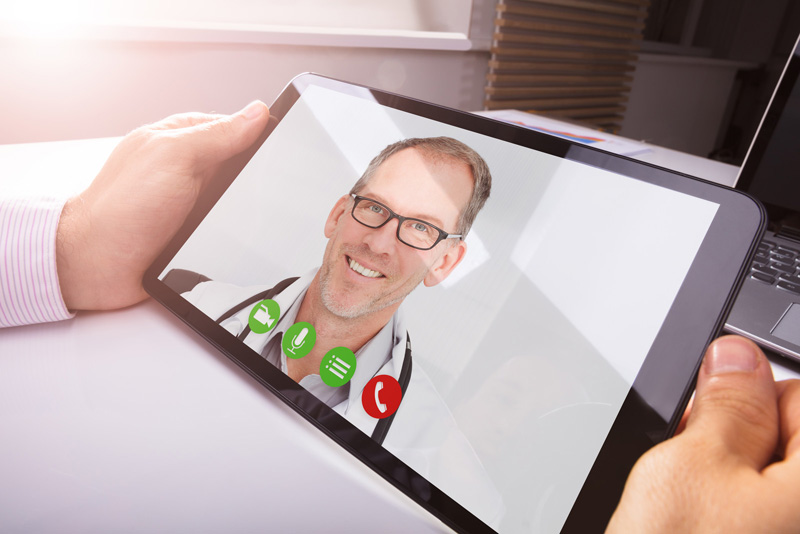
Telemedicine is a wonderful advancement in healthcare and an ideal option for reducing disparities in access to care, allowing persons who are too ill to travel to get care at home, and saving costs. As a medical transcription company in the US, we help physicians document these virtual encounters.
The COVID-19 outbreak has put the spotlight on telemedicine. It is proving an effective option to meet the care challenges created by the pandemic. Telehealth supports social distancing, allows physicians to engage with patients without in-person consults, prevents physical contact with symptomatic individuals, reduces chances of spread by preventing exposure in waiting rooms, and keeps high-risk people at home. As the use of the technology becomes widespread, providers and patients need to understand how it works to ensure a positive patient experience. Following certain guidelines can help physicians and patients make the most of virtual consultations.
- Know state and federal guidelines: New state and federal guidelines on telehealth implementation and mHealth services have been issued since the COVID-19 outbreak. Providers also need to comply with the appropriate licensing board in the patient’s state. Understand the rules and develop a compliance and payer-specific billing plan to cover coronavirus cases as well as other cases.
- Check malpractice insurance: Providers also need to check whether their malpractice insurer permits virtual video visits. They need to protect themselves against liabilities. The guidance on care provision during a pandemic is not clear, notes the American College of Cardiology (ACC).
- Appropriate patient: Based on their professional judgment and local, state or hospital guidelines, physicians should determine if telemedicine is appropriate for the patient. For instance, a patient who is too ill to speak or difficult to assess via a virtual consultation should be directed to a face-to-face or urgent visit. On the other hand, many chronic patients can also have scheduled teleconsultations from home to avoid face-to-face clinic visits and thereby minimize their risks of exposure to COVID-19.
- Be prepared: For telemedicine to succeed, both the provider and patient should be comfortable with the virtual visit and the technology. Physicians should be familiar with the patient’s health history and record, especially in the case of first-time virtual consults. Clinicians delivering care via telehealth should also ensure good placement of camera, microphone and speakers, ensure proper lighting in the exam room setting and dress in professional attire.
- Patient preparation: Patients should be prepared to handle their telemedicine visit. A smartphone, tablet, laptop or desktop with a camera and be savvy about the health device or app they are utilizing. They should also have the names and doses of their medications handy, as well as any other important information about their health such as their current symptoms, changes in conditions, drug allergies. Patients can also keep equipment like a thermometer, a blood pressure cuff or a flashlight at hand and use these if needed to help the clinician get a clearer idea about their health.
- Establish rapport: Providers should introduce themselves and make a non-medical connection with the patient. Establishing a rapport with the patient quickly is important as the duration of a telemedicine may be just 10-15 minutes. The key to doing this is to look into the camera and not down at the screen during a video call, explains Jonathan Mack, PhD, RN, NP, and the director of a telehealth training program at the University of California, San Diego (www.patientengagementhit.com). Also, experts say that webside manner is a key skill for clinicians providing telemedicine. Conveying empathy and compassion is necessary to calm fears and provide hope for patients.
- Inform patients of actions: Clinicians can also tell patients when they are taking notes during the telehealth encounter. They should take a history, answer questions, review medications, and provide guidance and reassurance. They can even share their screen to review imaging or provide education. and solicit questions from the patient if needed. They should inform patients of next steps such as treatment instructions, follow-up, prescription ordering, etc.
- Remote patient surveillance: Remote patient monitoring (RPM) devices such as fitness trackers and smartwatches can play an important role in telemedicine. In addition to measuring heart rates, the latest options can capture heart rates, coughs, breathing rate, and body temperature and even generate an ECG. By delivering patient data to physicians, RPM devices allow them to evaluate patients and prescribe treatment.
Documentation requirements for a telehealth service are generally the same as for a face-to-face encounter. However, the documentation requirements regarding documentation of history and/or physical exam in the medical record for such visits have been eased by the Centers for Medicare and Medicaid (CMS). Nevertheless, experts say that remote health will continue to be in vogue even after the current public health emergency for chronic care management, health and wellness, and other ancillary services that were “pushed aside to tackle the virus” (www,mhealthintelligence.com). Providers who outsource medical transcription to an experienced company can benefit from accurate and timely telemedicine documentation.


